Just like painters need the proper brushes and carpenters need a hammer and tape measure, chefs can’t complete their best work without the proper tools. Along with appliances like stoves and ovens, every culinary professional should have their own utility belt filled with hand-held tools.
Whether you’re just starting culinary school or have been working as a chef for years, make sure you always have access to these ten tools.
1. Chef’s Knife
It’s true there are all sorts of specialized knives out there. But if you only pick one, make it a versatile chef’s knife. With a 6-inch to 10-inch blade, this knife is small enough to handle easily yet large enough to tackle tough vegetables and meat cuts. Whether you’re dicing onions, carrots, and celery for a mirepoix or slicing fat off a chicken breast, a high-quality chef’s knife will help you quickly perform kitchen tasks while also keeping you safe.
In order to complete your best work, you’ll need to find a knife that feels like it was created just for your hand. Therefore, it may be helpful to head into a cooking store and try out a few different knives until you find a perfect fit.
Above all, make sure to keep the blade sharp! While it may sound counterintuitive, a sharp blade is much safer than a dull one.
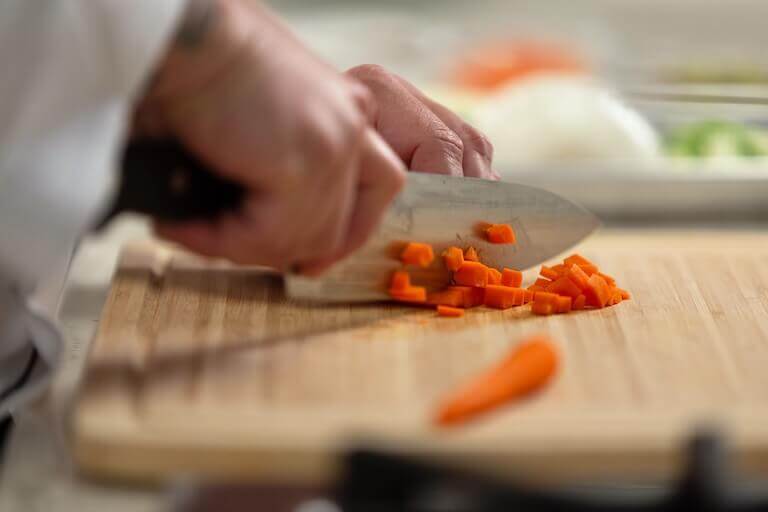
2. Honing Steel
As mentioned above, it’s crucial to keep your knives sharp! While you should periodically send your knife to a professional sharper or use a whetstone for a truly sharp edge, honing steel allows you to realign your knife blade in between sharpenings.
Stainless steel, ceramic, and diamond honing steel rods will all do the trick, so it’s simply a matter of what material you prefer. However, it is recommended that you choose a rod that is at least 12 inches long so you’ll have a greater surface area on which to realign your knife’s blade.
3. Bench Scraper
Every great chef knows the importance of a clean and organized workstation. And one of the best tools for keeping a tidy station is a bench scraper.
Although it’s not glamorous, this inexpensive tool allows you to quickly collect vegetable scraps into a bowl, remove sticky substances from your work table, and portion yeast dough into rolls.
“My favorite tool is a super flexible sharp edged bench scraper. I use it for everything from cutting dough to icing cakes!”* says Pastry Arts instructor Cheryl Herbert.
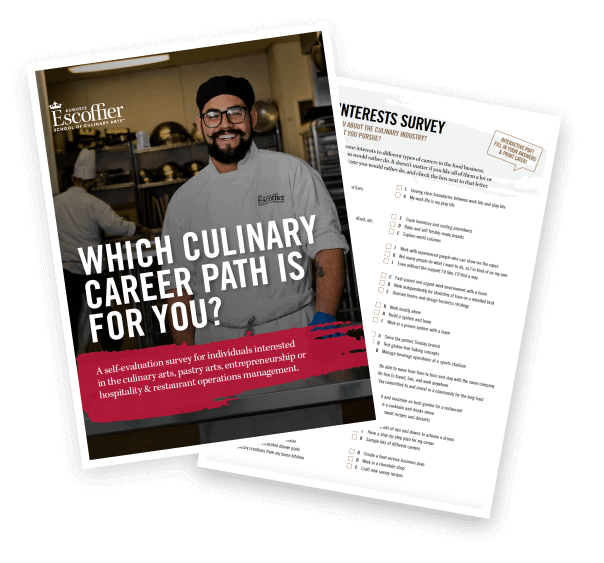
Take the Culinary Career Survey
We’ve compiled a checklist of all of the essential questions into one handy tool: career options, culinary interest surveys, educational opportunities, and more.
4. Wire Whisk
When you’re combining oil and vinegar to make an emulsion or whipping air into eggs for a fluffy omelet, a wire whisk can make your job easier. While a handheld or stand mixer can do the same job, these tools are often overkill for quick and simple tasks.
Escoffier’s Culinary Toolkit
When students begins classes in any of Escoffier’s Culinary Programs, they may receive a toolkit filled with knives, spatulas, and other crucial tools. They can use these tools throughout their programs and carry them along as they enter into a role in the culinary field.
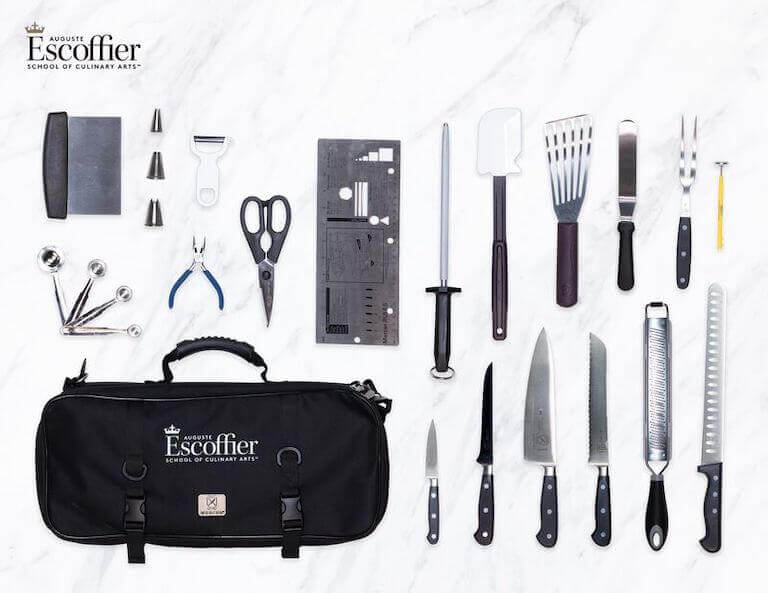
Example of Escoffier Residential Toolkit
5. Kitchen Scale
Every great baker is familiar with the precise measurement that a kitchen scale provides, but this tool can also come in handy when cooking.
Many recipes are written in weight since it is a more accurate measurement than volume, especially with baking ingredients. When it comes time to mix up one of these recipes, a kitchen scale is critical. Kitchen scales can also help limit the mess in a kitchen. Measuring by volume involves dirtying a measuring cup, but you can use a scale to measure ingredients directly into a mixing bowl or pot.
6. Fish Spatula
With all sizes and shapes of spatulas out there, it can be difficult to know which ones to choose. If you’re going to choose just one, make it the fish spatula.
While this spatula is perfect for flipping fish filets while they’re cooking in oil, it also has many other uses! Its thin blade easily slides under pancakes and eggs, while the hefty handle allows it to flip dense pork chops and burgers. Plus, its slotted design allows it to turn and drain fritters, fish, and other deep-fried foods.
“My favorite kitchen utensil is a fish spatula,” says Chef Christopher Moore. “It can be used as a whisk to finish a sauce and aids in plating.”*
7. Meat Thermometer
Experienced chefs may be able to tell if a chicken breast is perfectly cooked solely based on appearance, but many cooks find it helpful to rely on a meat thermometer. This simple device could be the difference between serving up a case of food poisoning and a perfectly-cooked cut of meat. Plus, you don’t risk drying out the meat by leaving it in the oven too long.
An easy-read digital thermometer is nice, but a simple probe thermometer can also do the trick.
8. Tongs
When you want to mimic the use of your hands but don’t want to burn your fingers on hot oil or a scorching pan, grab a pair of tongs. Look for a steel pair and opt for silicone-coated tips if you’d like to protect your nonstick pans.
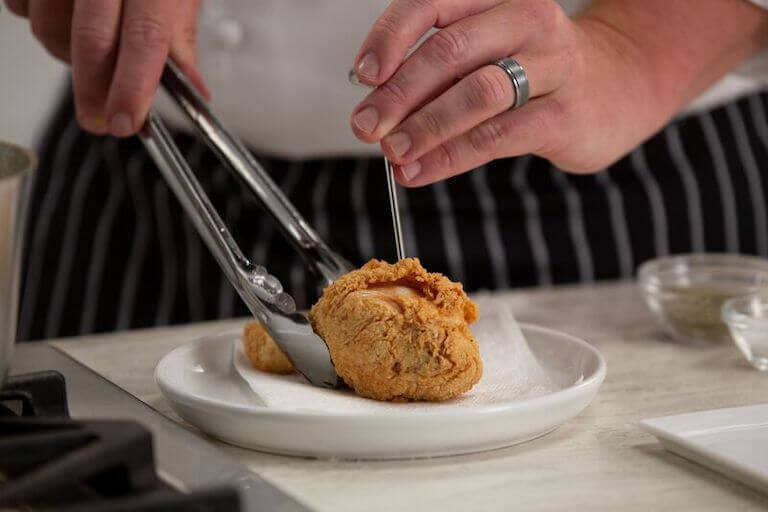
9. Mandolin
While knives have their place in the kitchen, it’s important to know when to ditch a single knife for a mandolin. This simple tool allows you to create thin and uniform slices of potatoes, carrots, cabbage, and other dense items.
As with knives, a sharp blade is essential! However, you should also be careful to protect your fingers from the mandolin’s razor-sharp blade.
10. Cutting Board
While it may not fit on a belt, a cutting board is a must-have item for any chef. Look for a board that’s easy to clean, and consider using separate labeled cutting boards for meats and vegetables. Remember, food safety is nothing to take lightly!
Flexible plastic or rubber cutting boards allow you to easily transfer ingredients to a bowl or pan, helping you keep up with the day’s tasks. And a heavier wooden cutting board can hold up to heavy cuts while not dulling your knives’ blades.
“I went from washing dishes and cleaning a commercial kitchen to managing my own within a two-year span. Escoffier has given me the culinary and business tools, resources, knowledge and self-confidence I need in order to make my dream a reality!”*
Mitchell Rodriguez, Online Culinary Arts Program Graduate
Education: The Most-Important Chef’s Tool
Even the best tools won’t be much help if you don’t know how to use them properly! That’s why it’s important to explore how to utilize each tool.
Escoffier’s Culinary Arts programs can introduce students to a variety of tools and also help provide the ability to practice using them while creating various dishes. And since these programs are taught by professional Chef Instructors, students can receive feedback to fine-tune their technique.
To learn more about the culinary arts, check these out next:
- The Art of Food Presentation
- What Are Functional Mushrooms and How Can They Be Used in Cooking?
- The Complete Glossary of Cooking Terms for the Culinary Arts
This article was originally published on March 22, 2017 and has since been updated.
*Information may not reflect every student’s experience. Results and outcomes may be based on several factors, such as geographical region or previous experience.

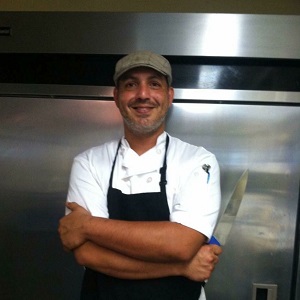 “I went from washing dishes and cleaning a commercial kitchen to managing my own within a two-year span. Escoffier has given me the culinary and business tools, resources, knowledge and self-confidence I need in order to make my dream a reality!”*
“I went from washing dishes and cleaning a commercial kitchen to managing my own within a two-year span. Escoffier has given me the culinary and business tools, resources, knowledge and self-confidence I need in order to make my dream a reality!”*

